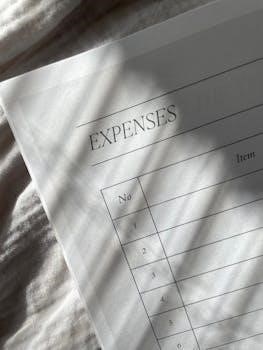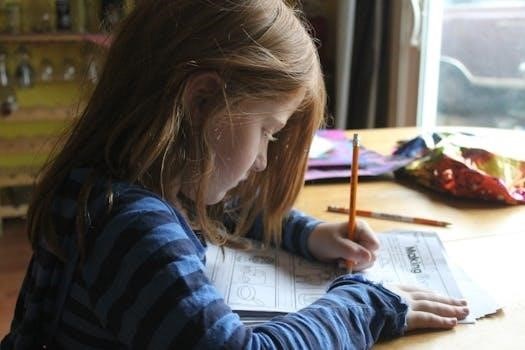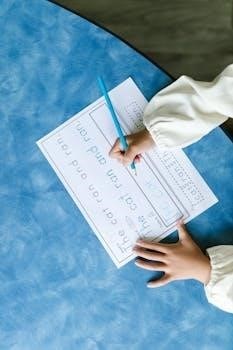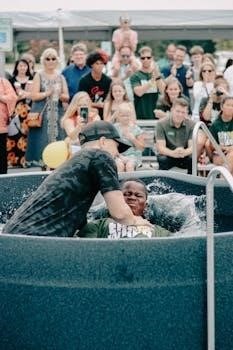Transformations Worksheet PDF⁚ An Overview
This worksheet provides a comprehensive set of practice problems covering translations‚ rotations‚ and reflections․ Each worksheet includes transformation rules‚ and six exercises to reinforce understanding of geometric transformations․
Translations Practice Problems
The translation practice problems section focuses on moving shapes on a coordinate plane without changing their size or orientation․ These problems often involve using vector notation to specify the direction and distance of the translation․ Students will be asked to translate various geometric figures‚ such as triangles‚ polygons‚ and boxes‚ and to plot the transformed images on a grid․ The exercises will provide practice in understanding how coordinates change when a figure is translated according to a given vector․ Additionally‚ these practice problems will help in improving skills related to identifying the coordinates of the original and the transformed shapes․ Furthermore‚ the problems might require students to determine the vector of translation when given the original and translated shape․ This section is designed to build a foundational understanding of translation transformations‚ which is essential for more complex geometrical concepts․ The exercises will vary in difficulty‚ allowing for a progressive learning experience that caters to different skill levels․
Rotations Practice Problems
This section provides exercises focused on rotating geometric shapes around a fixed point‚ primarily the origin․ Students will engage with problems that involve rotations of different angles‚ such as 90 degrees‚ 180 degrees‚ and 270 degrees‚ in both clockwise and counterclockwise directions․ The practice problems will challenge students to visualize how the coordinates of a shape change as it is rotated․ The section aims to solidify the understanding of rotational symmetry and its impact on geometric figures․ Students will also learn to predict the new coordinates of the vertices of a shape after rotation․ These exercises will enhance their ability to mentally manipulate shapes and grasp the concept of rotational transformations․ Furthermore‚ they will have to apply the rules of rotation in various contexts‚ and also‚ in the process‚ they will improve their understanding of the coordinate system․ This section is designed to build a solid foundation of rotation transformations․
Reflections Practice Problems

This section focuses on reflections‚ where students practice reflecting geometric shapes over specific lines․ These lines typically include the x-axis‚ y-axis‚ and other lines of symmetry․ Students will work on visualizing and drawing the reflected images of various shapes‚ understanding that the reflected image is a mirror image of the original shape․ The exercises will help students grasp the concept of reflection symmetry and how the coordinates of the points of a shape change after reflection․ This practice will also improve their ability to mentally manipulate shapes and predict the location of the new image․ By working through these problems‚ students will learn how to apply the rules of reflection to different geometric figures and gain a deeper understanding of the process․ The exercises are designed to help them visualize the flip across a line and how the reflected points are equidistant from that line․ The exercises are designed to build a solid foundation of reflections transformations․

Types of Transformations Covered
This section explores the three main types of transformations⁚ translations‚ rotations‚ and reflections․ The worksheets cover these topics‚ providing practice with each type of geometric manipulation․
Translations with Vector Notation
This section of the worksheet focuses specifically on translations‚ emphasizing the use of vector notation to describe the movement of shapes․ Students will learn how to apply vector notation to move figures across the coordinate plane․ These practice problems provide hands-on experience in translating shapes by a given vector․ The exercises involve understanding how a vector dictates both the direction and the distance of the translation․ Problems include translating various polygons‚ such as triangles and quadrilaterals․ By working through these exercises‚ students develop a strong grasp of how vectors are used to define translations․ This knowledge forms a crucial foundation for more advanced geometric concepts․ Each problem requires students to accurately move each vertex and recreate the transformed figure․ This reinforces the concept that all points on the original shape move the same distance and direction defined by the vector․
Rotations Around the Origin
This section concentrates on rotations‚ specifically around the origin of a coordinate plane․ Students will practice rotating various shapes by different angles‚ such as 90 degrees‚ 180 degrees‚ and 270 degrees‚ both clockwise and counterclockwise․ Each exercise provides a figure to rotate‚ demanding precise application of the rotation rules․ These exercises enable students to visualize and understand how points move when a shape is rotated around the origin․ The problems include diverse polygons to challenge and reinforce understanding of rotational transformations․ Students will learn to identify the coordinates of the transformed vertices․ Practicing these problems develops a strong spatial sense and familiarity with the effects of rotations․ The worksheets help students master the fundamentals of geometric rotations around the origin․ By working through these exercises‚ students improve their ability to visualize and perform rotations on a coordinate grid․ This skill is foundational for many areas of geometry․
Reflections Over Lines
This part of the worksheet focuses on reflections‚ specifically over lines‚ such as the x-axis and y-axis․ Students will encounter problems where they need to reflect various geometric shapes over these lines․ These exercises involve accurately determining the mirrored position of each vertex of the figure across the reflection line․ The practice includes diverse polygons to ensure a thorough understanding of how shapes change during reflections․ Through this practice‚ learners will reinforce their grasp of reflection principles‚ including how coordinates are altered when reflected over specific lines․ Students will develop skills in visualizing and correctly executing reflections‚ enhancing their understanding of symmetrical transformations․ The exercises aim to improve spatial reasoning and the ability to predict the outcome of reflections․ The worksheets facilitate a strong foundation in understanding reflections over lines․ By working through these problems‚ students become proficient in manipulating shapes through reflections‚ preparing them for more advanced geometry concepts․

Target Audience and Curriculum
These worksheets are designed for students in Years 7-8‚ focusing on geometry practice‚ especially rigid transformations․ The exercises align with the math curriculum requirements for this age group․
Year 7-8 Math Curriculum
The transformation worksheets are meticulously crafted to align with the Year 7-8 math curriculum‚ where transformations form a crucial component․ These worksheets provide ample practice opportunities for students to grasp the concepts of translation‚ rotation‚ and reflection‚ which are fundamental in geometry․ These exercises enable students to explore how shapes move and change within a coordinate plane‚ fostering a deeper understanding of spatial reasoning․ The materials are designed to support the curriculum’s emphasis on developing both procedural fluency and conceptual understanding․ Furthermore‚ the worksheets are structured to help students build a solid foundation in geometric transformations‚ which is essential for more advanced mathematical studies․ By integrating these practice problems‚ educators can ensure that students not only understand the rules of each transformation but also apply them effectively in various contexts‚ thus solidifying their mathematical knowledge and skills․ These worksheets are an ideal resource for reinforcing classroom learning and boosting student confidence․
Geometry Practice
These transformation worksheets are specifically designed for geometry practice‚ focusing on the core concepts of translation‚ rotation‚ and reflection․ The exercises utilize various shapes including triangles‚ polygons‚ and boxes‚ providing students with diverse scenarios to apply their understanding of geometric transformations․ These worksheets offer a structured approach to practice‚ enabling students to improve their skills in accurately transforming geometric figures․ By working through the problems‚ students solidify their knowledge of shape properties and their behavior under different transformations․ The practice problems encourage students to visualize and execute transformations on a coordinate plane‚ further developing their spatial reasoning abilities․ This practice is essential for reinforcing the rules of transformations and developing the confidence to tackle more complex geometric challenges․ Overall‚ these worksheets provide a crucial resource for students to build a strong foundation in geometry through hands-on practice․

Rigid Transformations Practice
These worksheets focus on rigid transformations‚ which include translations‚ rotations‚ and reflections․ The exercises on these worksheets help students practice the application of these transformations on geometric shapes‚ ensuring that they maintain their size and shape․ Students will gain hands-on experience in executing these transformations accurately‚ using coordinate planes to guide their work․ The rigid transformations practice is crucial for building a strong foundation in geometry and developing spatial reasoning skills․ Each problem on the worksheet requires students to either translate‚ rotate‚ or reflect shapes and then draw the transformed image on the grid‚ enhancing their understanding of these concepts․ This practice is essential for developing the ability to visualize and perform transformations accurately․ By engaging in these exercises‚ students will solidify their understanding of how geometric shapes behave under rigid transformations and develop their problem-solving skills in this area of mathematics․
